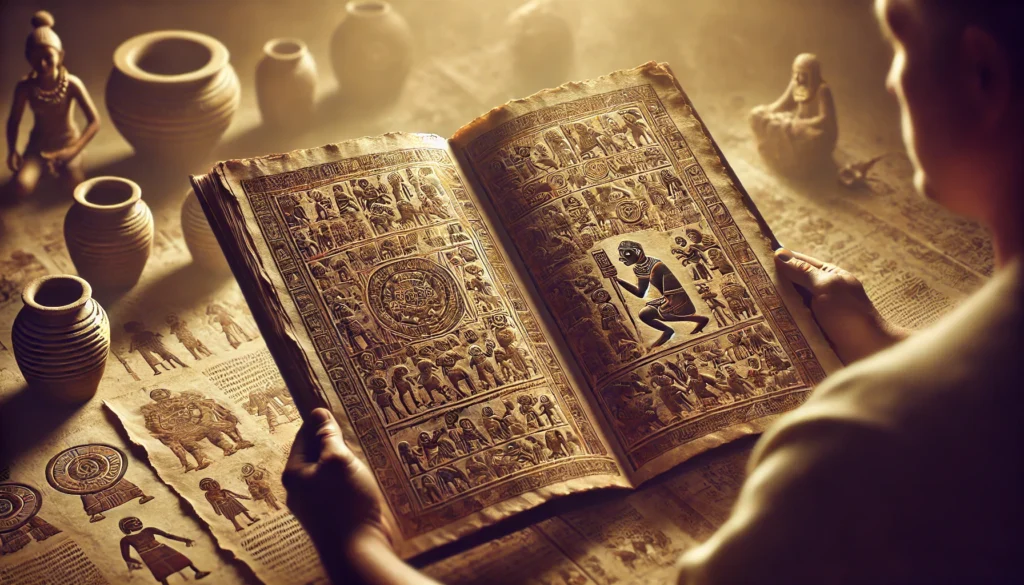The Boxer Codex, a remarkable manuscript dating back to the late 16th century, offers an unprecedented window into the lives, cultures, and societies of pre-Hispanic Philippines and other parts of Southeast Asia. This invaluable historical document, named after its previous owner Charles Ralph Boxer, has become a cornerstone in understanding the rich tapestry of Philippine history before the arrival of Spanish colonizers.
Origin and Dating
The Boxer Codex is believed to have been created between 1590 and 1595. Its exact origins remain a subject of scholarly debate, but most historians agree that it was likely commissioned by the Spanish colonial government in the Philippines. The codex contains a wealth of information, including detailed descriptions and vivid illustrations of the various peoples inhabiting the Philippine archipelago and neighboring regions.
Physical Description
The manuscript consists of 270 pages, measuring approximately 30 cm by 21 cm. It is bound in vellum and contains 75 colored illustrations, which are particularly valuable for their depiction of the clothing, weapons, and daily life of pre-colonial Filipinos.
Contents of the Boxer Codex
The Boxer Codex is a treasure trove of information, covering a wide range of topics related to the Philippines and other parts of Southeast Asia. Its contents can be broadly categorized into several key areas:
Ethnographic Descriptions
- Detailed accounts of various ethnic groups in the Philippines
- Descriptions of customs, traditions, and social structures
- Information on religious beliefs and practices
Geographical Information
- Maps and descriptions of different islands and regions
- Notes on climate, flora, and fauna
Historical Narratives
- Accounts of early Spanish expeditions to the Philippines
- Descriptions of interactions between Spanish colonizers and native populations
Illustrations
- 75 colored drawings depicting various ethnic groups
- Illustrations of clothing, weapons, and daily life
Ethnographic Insights from the Boxer Codex
One of the most valuable aspects of the Boxer Codex is its detailed ethnographic descriptions of various groups inhabiting the Philippines and nearby regions. These accounts provide a rare glimpse into the diverse cultures that existed in the archipelago before widespread Spanish colonization.
Tagalogs
The codex offers extensive information on the Tagalogs, one of the major ethnic groups in the Philippines. It describes their social structure, religious beliefs, and customs in great detail.
- Social hierarchy: The codex mentions the existence of a nobility class called “maharlika” and describes the role of local leaders or “datus.”
- Religious practices: It details animistic beliefs and the role of priestesses called “babaylan.”
- Customs: The manuscript describes marriage practices, funeral rites, and other important social customs.
Visayans
Another significant portion of the codex is dedicated to the Visayan people, providing valuable insights into their way of life.
- Body modifications: The codex describes the practice of teeth filing and body tattooing among the Visayans.
- Warfare: It details Visayan weapons, armor, and naval capabilities.
- Social customs: The manuscript provides information on Visayan clothing, ornaments, and social gatherings.
Other Ethnic Groups
The Boxer Codex also contains information on other groups such as the Zambals, Cagayans, and various non-Philippine peoples like the Chinese, Japanese, and inhabitants of the Moluccas.
Artistic Value of the Boxer Codex
The 75 colored illustrations in the Boxer Codex are of immense artistic and historical value. These vivid depictions provide visual evidence of pre-colonial Filipino life that is unparalleled in its detail and scope.
Clothing and Adornments
- The illustrations show the diverse clothing styles of different ethnic groups.
- They depict various forms of jewelry and body ornaments, including gold accessories.
Weapons and Armor
- The codex illustrates a wide range of weapons used by different groups, including swords, spears, and bows.
- It also shows various types of armor and shields used in warfare.
Daily Life and Activities
- The drawings provide glimpses into everyday activities such as fishing, farming, and trading.
- They also depict social gatherings, religious ceremonies, and other cultural practices.
Historical Context of the Boxer Codex
To fully appreciate the significance of the Boxer Codex, it’s essential to understand the historical context in which it was created.
Spanish Colonial Period
The codex was compiled during the early years of Spanish colonization in the Philippines. This period was marked by:
- The establishment of Spanish colonial administration
- The beginning of widespread Christianization efforts
- Early resistance movements against Spanish rule
Purpose of the Codex
Scholars believe the Boxer Codex was created to serve multiple purposes:
- To provide information to Spanish authorities about the peoples they were governing
- To assist in missionary efforts by providing cultural insights
- To document the various cultures encountered by the Spanish in Southeast Asia
Scholarly Debates and Interpretations
The Boxer Codex has been the subject of extensive scholarly analysis and debate since its rediscovery in the 20th century.
Authorship
While the exact author of the codex remains unknown, several theories have been proposed:
- Some scholars attribute it to a Spanish official or missionary
- Others suggest it may have been a collaborative effort involving multiple contributors
Accuracy and Bias
Researchers have debated the accuracy of the information presented in the codex:
- Some argue that it provides a relatively unbiased account of pre-colonial Philippine life
- Others point out potential European biases in the descriptions and illustrations
Comparative Analysis
Scholars have compared the information in the Boxer Codex with other historical sources:
- Archaeological evidence has corroborated many of the codex’s descriptions
- Other Spanish colonial documents have been used to cross-reference the information
The Boxer Codex in Modern Philippine Studies
The rediscovery and publication of the Boxer Codex have had a significant impact on Philippine historiography and cultural studies.
Contributions to Historical Research
- The codex has provided new insights into pre-colonial Philippine society and culture
- It has challenged some previously held assumptions about early Filipino life
Cultural Revival
Information from the Boxer Codex has been used in efforts to revive and preserve traditional Filipino culture:
- Artists and designers have drawn inspiration from the illustrated clothing and ornaments
- Cultural organizations have used the codex to reconstruct pre-colonial practices and rituals
Educational Value
The Boxer Codex has become an important resource in Philippine education:
- It is frequently referenced in history textbooks and academic papers
- Museums and cultural institutions often feature information and reproductions from the codex
Preservation and Accessibility of the Boxer Codex
Ensuring the preservation and accessibility of this invaluable historical document is crucial for future research and cultural understanding.
Current Location
The original Boxer Codex is currently housed in the Lilly Library at Indiana University in Bloomington, Indiana, USA.
Digitization Efforts
To make the codex more accessible to researchers and the public:
- High-resolution digital scans of the entire manuscript have been created
- These digital copies are available for study at various institutions and online platforms
Conservation Measures
Given the age and fragility of the manuscript, extensive conservation efforts have been undertaken:
- Climate-controlled storage to prevent deterioration
- Careful handling protocols for researchers accessing the original document
Comparative Analysis with Other Historical Sources
To fully appreciate the value of the Boxer Codex, it’s important to consider how it compares with other historical sources from the same period.
Spanish Colonial Documents
- The Boxer Codex provides more detailed ethnographic information than many official Spanish reports
- It offers a more nuanced view of indigenous cultures compared to some missionary accounts
Indigenous Sources
- The codex complements information found in pre-colonial Filipino epics and legends
- It provides a European perspective that can be compared with native oral traditions
Archaeological Evidence
- Many descriptions in the Boxer Codex have been corroborated by archaeological findings
- The illustrations have helped in interpreting artifacts discovered in excavations
The Boxer Codex and Philippine National Identity
The rediscovery of the Boxer Codex has had profound implications for Philippine national identity and cultural pride.
Reclaiming Pre-colonial Heritage
- The codex has helped Filipinos reconnect with their pre-colonial past
- It has sparked renewed interest in indigenous traditions and practices
Challenging Colonial Narratives
- The detailed descriptions in the codex challenge some colonial-era stereotypes about pre-Hispanic Filipinos
- It provides evidence of complex societies and advanced cultures before Spanish arrival
Cultural Diplomacy
- The Boxer Codex has become a point of pride in showcasing Philippine cultural heritage internationally
- It has been featured in exhibitions and cultural exchanges, promoting Philippine history and culture abroad
Future Research Directions
As scholarship on the Boxer Codex continues to evolve, several areas of potential future research have emerged:
Interdisciplinary Studies
- Combining historical analysis with anthropological and archaeological research
- Using modern scientific techniques to analyze the materials and pigments used in the codex
Comparative Studies
- Exploring connections between the Boxer Codex and other Southeast Asian historical documents
- Investigating potential influences on later colonial-era writings about the Philippines
Digital Humanities
- Developing interactive digital platforms to make the codex more accessible to the public
- Using computer analysis to uncover new patterns or information within the text and illustrations
Conclusion
The Boxer Codex stands as a testament to the rich and diverse cultures that existed in the Philippines before Spanish colonization. Its detailed descriptions and vivid illustrations provide an unparalleled glimpse into pre-Hispanic Philippine life, offering valuable insights for historians, anthropologists, and cultural scholars. As research on this remarkable document continues, it will undoubtedly continue to shape our understanding of Philippine history and contribute to the ongoing process of cultural reclamation and national identity formation.
Disclaimer: While every effort has been made to ensure the accuracy of the information presented in this blog post, our understanding of historical documents is continually evolving. Readers are encouraged to report any inaccuracies or new findings related to the Boxer Codex, so that this information can be promptly reviewed and updated. The field of Philippine studies is dynamic, and new research may shed additional light on the interpretations presented here.




